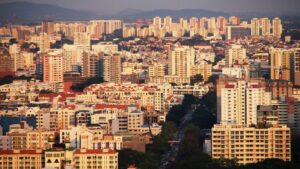Heat and the city: High-rise areas get almost twice as hot as low-rise residential areas
November 28, 2022

In ‘Heat and the city: High-rise areas get almost twice as hot as low-rise residential areas’ (The Straits Times, November 2022), Professor Matthias Roth (NUS Geography) was featured for leading a project that studies the variation of temperature across Singapore.
Areas with dense clusters of buildings are warmer than less dense housing estates. A compact group of high-rise buildings is 4.3°C hotter than undeveloped land in Lim Chu Kang on average. In contrast, a dispersed low-rise residential area with some vegetation is the coolest.
The variation of temperature across the city is caused by the urban heat island effect, a phenomenon whereby densely built areas experience higher air temperatures than undeveloped rural areas. When energy from solar radiation trapped in urban structures during the day is released as heat at night, the urban heat island effect becomes particularly palpable.
The six-year project led by Prof Roth is one of the most comprehensive studies in a tropical city to date. It has confirmed that rising temperatures in Singapore are not only due to global warming but also local urbanization. Prof Roth believes that the study results will be useful for understanding areas vulnerable to heat risk and climate-sensitive urban planning. For example, preserving existing natural areas and planting more shade-providing vegetation will be part of the solution to alleviate the heat.
Read the article in The Straits Times here: https://www.straitstimes.com/singapore/environment/heat-and-the-city-high-rise-areas-get-almost-twice-as-hot-as-low-rise-residential-areas
